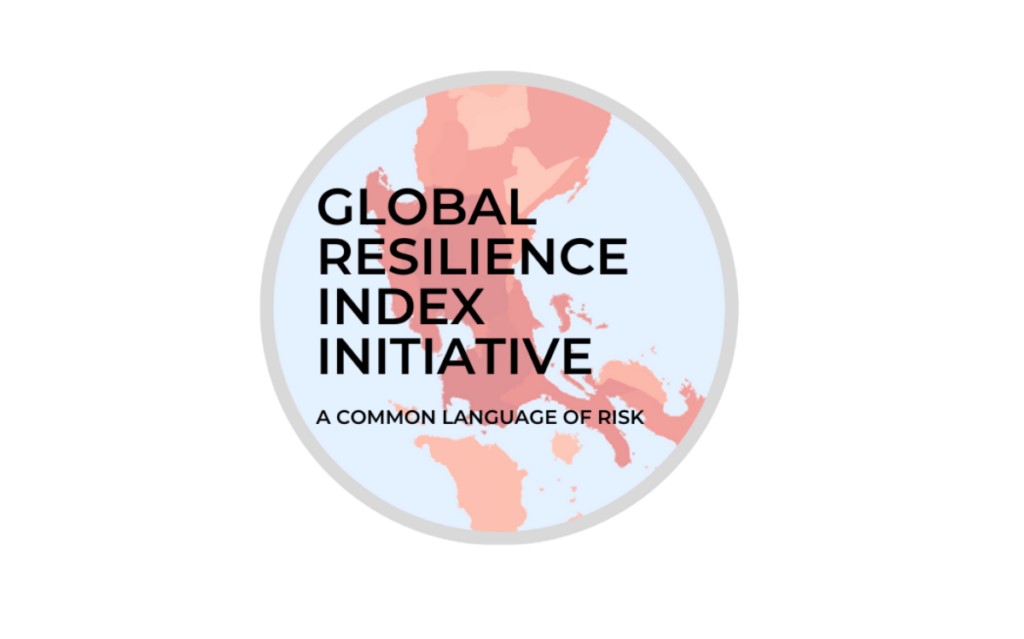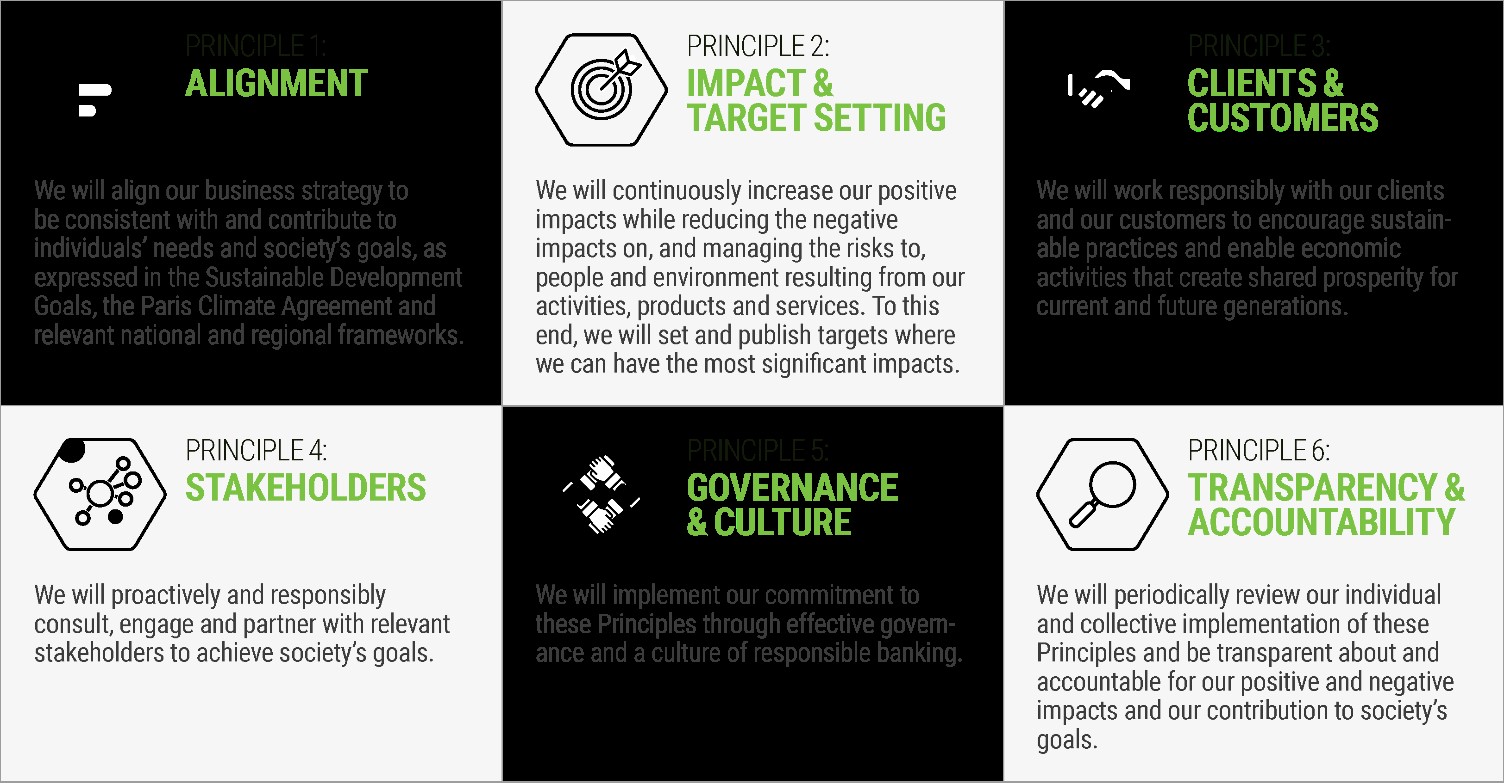Monday, 15th November 2021
The S-400 Deal and India’s Strategic Autonomy
In News
The delivery of the Russian S-400 Triumf air defence systems to India has started and the first division will be delivered by the end of 2021.
The Diplomatic Issue at helm
- The timing of delivery of S-400 Triumf air defence systems become significant because
- The Russian President is scheduled to visit India in December.
- The India-U.S. 2+2 ministerial dialogue is also scheduled for early December where the possibility of sanctions from the U.S. under the Countering America’s Adversaries Through Sanctions Act (CAATSA) could come up for discussion.
Why is the S-400 deal so important to India?
- India’s national security considerations: S-400 is very important for India’s national security considerations, especially as it faces new threats from China, Pakistan and Afghanistan.
- Easy integration of S-400: Integrating the S-400 into the national air defence architecture will be much easier as India has a large number of legacy Russian air defence systems, a major reason India did not consider the US air defence systems as a viable alternative.
- Assertion of ‘strategic autonomy’: Buying the S-400 is a way for India to assert its ‘strategic autonomy’. This stated principle of Indian foreign policy wavered under pressure from US, when India agreed to stop buying Iranian oil over the threat of sanctions in 2019.
- This has caused India both financial and reputational damage. Not giving in to the US’s unilateral sanctions over S-400 would be one way to restore some of that.
- Importance of Russia: Currently, more than 65% of Indian armed forces equipment is of Russian origin and India continues to bank on Russia for spare parts, though Russian equipment percentages are steadily declining.
- Russian-origin equipment in service necessitates support from Russia. India has also signed a $3-billion deal to lease a Russian nuclear-powered Akula Class submarine, likely to be delivered by 2025.
- India must also keep Russia away from providing Pakistan with similar equipment as India. Hence, terminating its relations with Russia is illogical and would damage India’s defence preparedness.
Why should US not proceed with sanctions on India?
- India-US relations have grown over the past decade. Currently, they are close allies in the Quad, which is a diplomatic grouping involving a military element, aimed at containing China.
- India is the sole military and economic power in Asia to counter China. The US is aware that it cannot brush aside Indian interests.
- India-US defence trade has surpassed $20 billion and is likely to grow further. The US attempts to impose CAATSAon India would affect India-US arms deals, a major benefit to the US. India has resources to procure its own military hardware and there are many global suppliers wooing India.
- India and the US have signed basic foundation agreements (LEMOA, BECA etc.) which involve close cooperation in matters of defence. Mutual trust between the US and India must be built, not broken.
- The recent US National Defence Authorisation Act (NDAA) 2021 has focused on the Indo-Pacific. Currently, India and the US are collaborating on multiple issues, including Afghanistan.
- It is illogical to damage this cooperation and push growing ties onto a slippery slope for a procurement considered essential in Indian national interest.
Conclusion: India has moved away from its traditional non-allied status with a pro-Russia tilt to being close to US strategically, though it maintains close ties with Russia and works alongside it in the SCO (Shanghai Cooperation Organisation), RIC (Russia-India-China trilateral) and BRICS (Brazil-Russia-India-China-South Africa). It is evident that India will not back down. Nor will India surrender its strategic autonomy and become dependent on the US. It has explained this clearly to the US leadership. On the contrary, the US would lose a close and strong ally, which would leave Russia and China strengthened.
Sources:
Supreme Court’s RERA jurisdiction verdict
In News
Recently, the Supreme Court has held the Real Estate (Regulation and Development) Act, 2016 [RERA] is retroactive in its application.
Details of the verdict
The judgment dated November 11 came in Newtech Promoters and Developers Limited v. State of UP case. Apart from the technicalities of RERA, one of the issues considered by the Apex Court was whether RERA is retrospective/retroactive in its operation and what will be its legal consequence if tested on the anvil of the Constitution of India.
Following are the key observations of the verdict:
- Taking note of the statutory provisions especially Section 3 of the RERA, the court observed that the RERA is retroactive (taking effect from a date in the past) in nature and covers all ongoing projects for which completion certificate has not been issued.
- Court said that the legislative intent is to make the Act applicable not only to the projects which were yet to commence after the Act became operational but also to bring under its fold the ongoing projects and to protect the rights of the stakeholders, including allottees/home buyers, promoters and real estate agents while imposing certain duties and responsibilities on each of them and to regulate, administer and supervise the unregulated real estate sector within the fold of the real estate authority.
- Court made it clear that RERA Act does not apply to the projects already completed or to which the completion certificate has been granted at the commencement of the Act.
- Parliament is always competent to enact any law affecting the antecedent events: Court held that merely because enactment is made retroactive in its operation, it cannot be said to be either violative of Articles 14 or 19(1)(g) of the Constitution of India. To the contrary, the Parliament indeed has the power to legislate even retrospectively to take into its fold the preexisting contract and rights executed between the parties in the larger public interest.
- Thus, it is clear that the statute is not retrospective merely because it affects existing rights or its retrospection because a part of the requisites for its action is drawn from a time antecedent to its passing. At the same time, retroactive statute means a statute which creates a new obligation on transactions or considerations already passed or destroy or impair vested rights.
- Court also held that the RERA, 2016 empowers the RER authority to delegate its power and functions to any of its member, by general or special order. The regulatory authority has exclusive jurisdiction to direct refund of the amount, and interest on the refund amount, or directing payment of interest for delayed delivery of possession, or penalty and interest thereon, to the allottee.
- The Court also observed that in cases of default, both the home buyers and promoters are equally protected by the statute.
What Next?
- After the RERA Act was notified on May 1, 2016, all the states were required to notify final rules within six months. The major motive of the RERA Act was to make the promises made by the Builders and Developers binding in a legal manner. However, most states had diluted the rules in favour of developers.
- Several state RERA authorities had tweaked their rules to exclude even ongoing projects that had not received completion certificates by introducing additional conditions.
- For instance, Telangana had excluded the ongoing projects, for which building permissions were received prior to January 2017, from RERA jurisdiction, effectively keeping all ongoing projects out of RERA.
- This ruling has reaffirmed the jurisdiction of RERA on all real estate projects that were ongoing at the time of the law getting enacted.
- Regulations of RERA authorities in states including Uttar Pradesh, Haryana, Punjab, Karnataka, Telangana and Tamil Nadu are currently not in line with this judgement and may need to amend their rules to ensure all ongoing projects get covered under RERA.
Sources:
- Supreme Court’s RERA jurisdiction verdict may compel states to amend rules
- Supreme Court Upholds Application Of RERA To Real Estate Projects Ongoing At Act's Commencement
- Real Estate Regulatory Authority can delegate its powers to hear complaints from homebuyers: SC
- Regulatory Authority Has Exclusive Jurisdiction To Direct Refund To Allottee
Mental Health Atlas 2020
In News: World Health Organization (WHO) has recently released the Mental Health Atlas.
About the Report
- Objective: The Mental Health Atlas project was initiated by WHO to map mental health resources globally (that include mental health policies, legislation and financing, the availability and utilization of mental health services, human resources and information/data collection systems) and to provide an up-to-date overview of mental health system profiles in different countries and regions.
- The 2020 version of the Mental Health Atlas tracks progress in implementing WHO’s Comprehensive Mental Health Action Plan 2013–2020.
Key Findings of the Mental Health Atlas 2020
- Information Systems and Research for Mental Health: It has been observed that 31% of WHO Member States regularly compile mental health-specific data.
- The percentage of countries reporting no mental health data compiled in the last two years has declined from 19% in 2014 to 15% in 2020.
- Mental Health System Governance: 75% of Member States have a stand-alone policy or plan for mental health, which is an increase from 68% in 2014.
- 51% of these Member States have reported full alignment of their policy with international and regional human rights instruments.
- Financial and Human Resources: Levels of public expenditure on mental health are low (a global median of 2.1% of government health expenditure) and particularly meagre in low- and middle-income countries.
- Globally, the median number of mental health workers is 13 per 100 000 population.
- There continues to be extreme variation between World Bank income groups (from below 2 workers per 100 000 population in low-income countries to over 60 in high-income countries).
- Service Availability and Uptake: Only 25% of WHO Member States reported the integration of mental health into primary health care.
- Hospital Beds: The median number of mental hospital beds per 100 000 population ranges from below 2 in low-income countries to over 25 in high-income countries.
- Admission Rate and Outpatient Visit: The median admission rate per 100 000 population increased from 36 admissions in 2014 to 72 admissions in 2020 and outpatient visits per 100 000 population ranged from 100 visits in low-income countries to over 5000 visits in high income countries.
- Community-based mental health facilities: There is extreme variation in community-based mental health facilities between income groups, with 0.11 facilities per 100 000 population in low-income countries and 5.1 facilities per 100 000 population in high-income countries.
- Mental Health Promotion and Prevention: 52% of WHO Member States, have at least two functioning national, multisectoral mental health promotion and prevention programmes.
- The global age-standardized suicide rate in 2019 was estimated to be 9.0 per 100 000 population which is a 10% reduction in the rate of suicide since the 2013.
Source:
Drug abuse and the abuse of the law
In News
The Union Ministry of Social Justice and Empowerment has proposed certain changes to some provisions of the Narcotic Drugs and Psychotropic Substances (NDPS) Act of 1985.
What is Drug Abuse and its status in India?
- Meaning: Drug abuse or substance abuse refers to the use of certain chemicals for the purpose of creating pleasurable effects on the brain.
- Types: There are three types of drugs — party drugs, prescription drugs and others, namely inhalants (also known as synthetic drugs).
- India’s Status: A 2019 report of the Union Ministry of Social Justice and Empowerment revealed that cannabis and opioids are the most commonly abused substances in India after alcohol. Nationally, an estimated 850,000 people inject drugs, the report said.
- Causes of Drug Abuse
What is the Legal Framework for Drug Abuse in India?
- International Conventions: India is a party to the three United Nations drug conventions – the 1961 Single Convention on Narcotic Drugs (1961 Convention), the 1971 Convention on Psychotropic Substances (1971 Convention) and the 1988 Convention against Illicit Traffic in Narcotic Drugs and Psychotropic Substances (1988 Convention).
- Narcotic Drugs and Psychotropic Substances Act, 1985: The NDPS Act came into force on 14 November 1985, replacing the Opium Acts and the Dangerous Drugs Act. The 1940 Drugs and Cosmetics Act, 1940, however, continue to apply.
- The NCB is the central law enforcement and intelligence agency under the Union Ministry of Home Affairs. The agency, established on March 17, 1986, is tasked with combating drug trafficking and the use of illegal substances under the NDPSAct, 1985.
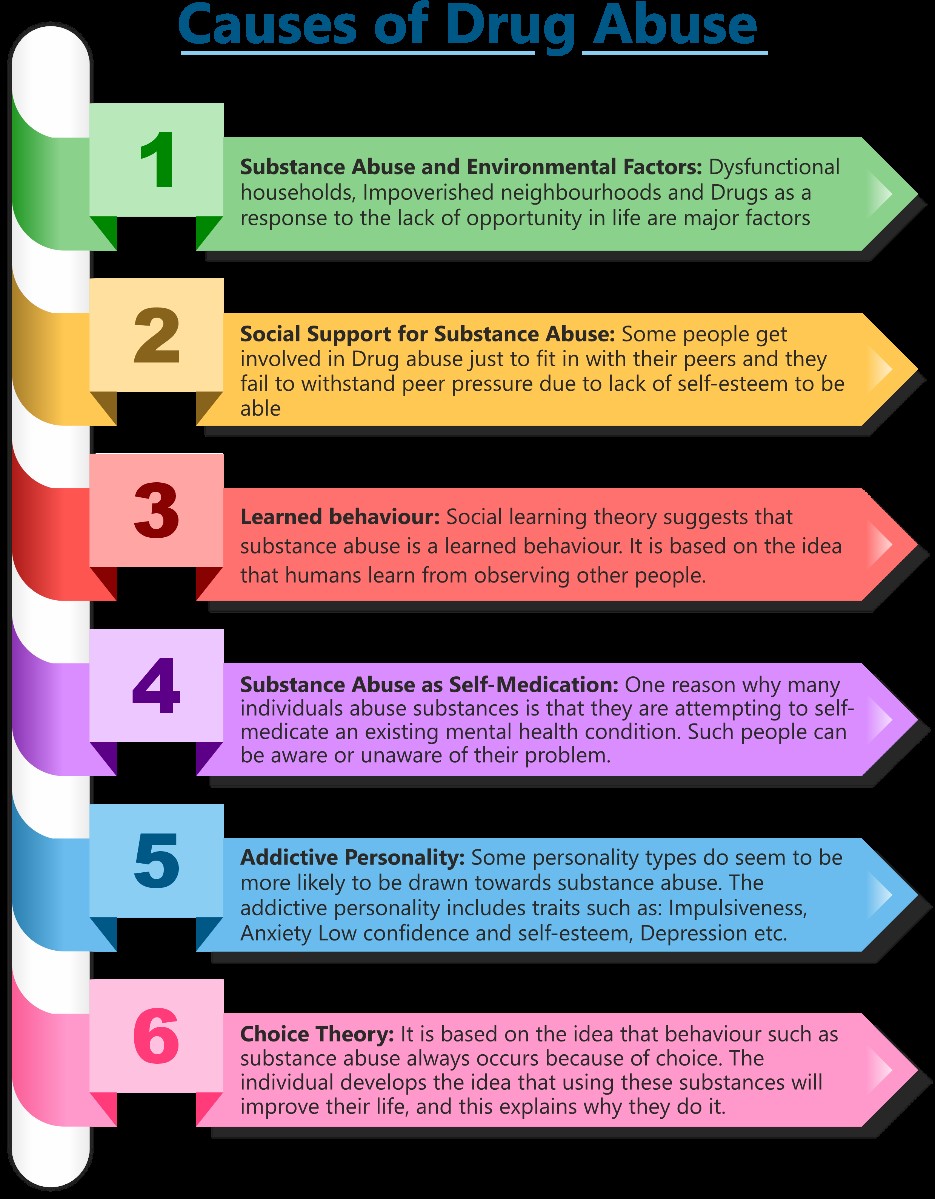
- The Act covers three broad classes of substances:-
- Narcotic drugs, that is, those covered under the 1961 Convention;
- Psychotropic substances or those covered under the 1971 Convention
- “Controlled substances” that are used to manufacture narcotic drugs or psychotropic substances.
Why bail proceedings for offences under NDPS Act are complex and open to abuse?
- First arrest and then investigate principle for investigations under the NDPS Act is problematic. The procedure of seizing narcotic drugs is important first. Section 50 of the Act (conditions under which search of persons shall be conducted) needs to be followed scrupulously.
- When officials stumble upon a person carrying drugs during raids or a routine check, the drugs must be seized in front of a Gazetted Officer or a Magistrate.
- Leans towards incarceration rather than bail: Section 37(1) mandates that an accused person should not be granted bail unless the court has reasonable grounds to believe that he is not guilty and that he is not “likely to commit any offence while on bail”. The provision is on the same terms as anti-terror laws.
- In this context, the kind of evidence being put forth and the way this is being done in cases involving celebrities, the situation gets further complicated.
- Cognisable Offences: Every offence under the Act is cognisable, which means they are serious enough for the police to arrest without a warrant. Section 2 of the Act shows a long list of prohibited activities which amount to “illicit traffic”.
- These include cultivation of coca plant to production, manufacture, possession etc. and even letting out premises to persons engaged in illegal activities under the Act.
- Wide Ranging Powers: The power given to the Central government is wide. The Act declares that the “Central government shall take all such measures as it deems necessary or expedient for the purpose of preventing and combating abuse of narcotic drugs and psychotropic substances and the illicit traffic”.
- Power without Requisite Competence: The statute allows the Centre and States to empower officers, who are above the rank of peon, sepoy or constable in central excise, narcotics, customs, revenue intelligence or any other department to act on “personal knowledge” or third-party information given in writing, with the power to enter, search, seize and arrest without warrant or authorisation.
- Lack of Data Protection Compounds the Problem: With the lack of a proper data protection bill, using WhatsApp chats and notes on mobile phones to establish criminal intent is a minefield for lawyers and judges alike. The ambiguity in interpretation as well as the aspect of solely relying on electronic communication, makes it more difficult.
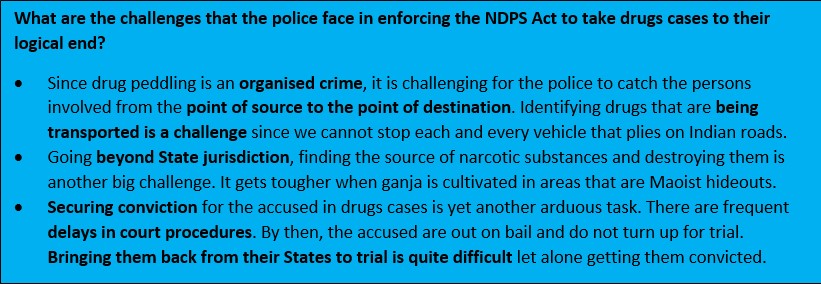
How is the proposed amendment to the NDPS Act trying to resolve these challenges?
- De-criminalization: According to the proposals made by the Ministry of Social Justice, the Act should not only talk about replacing “consumption” with “other than personal consumption (in small quantity)” but also remove the word “addict” and replace it with “person with substance use disorder”.
- This will make a clear distinction between the person who is in possession or using the drug, whether it is for personal consumption.
- De-addiction: In relation to poppy straw, opium, cannabis, psychotropic substances and other drugs and narcotics, where the contravention involves small quantity and possession is solely for personal consumption, it is proposed that a mandatory admission at a government-run or supported rehabilitation or de-addiction center be encouraged.
- The UN has supported decriminalizing drug possession for personal consumption and in small quantities. 28 countries across the world have decriminalized possession with sanctions such as fines, redirection to educational and social centers. This has helped in reducing hindrances for people to access healthcare, harm reduction and legal services,
Decriminalisation apart, what other steps can be taken to check the drug menace in the country?
- Family is the first School: Our approach to tackling the problem should begin from home. While bringing up their wards, parents have to act as confidants first. Children also emulate the lifestyle of Parents. So, role of parents becomes even more crucial.
- Societal Level Awareness: Checking drugs usage is not the job of only the police. The society needs to become proactive and also act as a support system to youngsters to cope against bad influence.
- Example: Teachers should keep an eye on school surroundings to ascertain whether anyone is selling or procuring drugs.
- Learnings from other countries: The government could also study some of the best practices in the world. In Iceland, for example, a community-led approach has worked wonders. From introducing aptitude tests which revealed the inclinations of students to persuading parents to keep liquor and cigarettes out of reach of the youth, the country took various measures to tackle the problem and weaned away 70-80% of its young population from drugs. It also helped drastically reduce the usage of drugs.
Question: Discuss how the stringent provisions of the Narcotic Drugs and Psychotropic Substances Act, 1985 are prone to abuse.
Sources:
- Should the NDPS Act be amended?
- Modi govt plans changes to NDPS Act, could decriminalise possession of small quantities of drugs
- Explained: What is NCB, its mission, how does it fight drug trafficking?Explained: What is NCB, its mission, how does it fight drug trafficking?
- Why bail proceedings for offences under NDPS Act are complex and open to abuse
- Reasons for Substance Abuse
This Day in History - Janjatiya Gaurav Divas
On November, 15, 1875, tribal freedom fighter Birsa Munda was born. The government has announced that Birsa Munda’s birth anniversary to be celebrated as Janjatiya Gaurav Divas this year onwards. Born in the tribal belt of the undivided Bihar, Birsa Munda rallied tribals against the British colonial rule and conversion activities and died in 1900 in Ranchi jail. Birsa Munda fought bravely against the exploitative system of the British colonial government and spearheaded the movement against British oppression giving a call for ‘Ulgulan’ (Revolution). Munda led the tribals essentially to prevent land grabbing by the non-tribals ending them up as bonded labourers in their land. He was also called ‘Dharti Abba’.

Source:
Image of the Day - Belarus-Poland border issue
This is image of migrants trying to cross from the Belarus side of the border with Poland. An estimated 3,000 to 4,000 migrants and refugees, many of whom are reportedly from the Middle East and Afghanistan, are camped out in what is effectively a no-man’s-land between Belarus and Poland after being denied entry to the EU nation. The crisis erupted earlier this year, when Belarusian President, angered by the toughened measures by EU, announced that Belarus would stop trying to prevent undocumented migrants and refugees from reaching the EU, arguing the EU’s sanctions deprived his government of the funds needed to do so. Since then, EU member states bordering Belarus, including Lithuania, Latvia and Poland, have reported sharp increases in the number of people attempting to cross their borders.

Sources:
Norovirus
- Context: Kerala health minister has recently issued guidelines after Norovirus was confirmed in the state’s Wayanad district.
- Norovirus is an animal-borne disease transmitted through contaminated water and food.
- It is easily transmitted through close contact with people or via their excrement and vomit or by touching contaminated surfaces.
- It can also be spread by eating food that has been prepared or handled by someone with the stomach bug.
- Its symptoms include Diarrhoea, abdominal pain, vomiting, nausea, high temperature and headache that can lead to dehydration and further complications.
- It causes gastrointestinal illness, including inflammation of the lining of the stomach and intestines.
- It does not significantly affect healthy people but it can be serious in young children, the elderly and people with co-morbidities.
- With proper prevention and treatment, the disease can be cured quickly.

Source:
- Norovirus confirmed in Kerala’s Wayanad. Here’s what you need to know
- Norovirus confirmed in Kerala's Wayanad. All you need to know about infection
Image Source:
Fishing Cats
- Context: The Wildlife Institute of India Conservation Biologists have been planning to collar ten Fishing Cats in the Coringa Wildlife Sanctuary (CWS) in Andhra Pradesh.
- Fishing Cat (Prionailurus viverrinus) is a feline (a cat or a member of the cat family) with a powerful build and stocky legs.
- The size of an adult ranges from 57-78 cm and weighs between 5-16 kg.
- It is an adept swimmer and enters water frequently to prey on fish as its name suggests.
- These cats generally inhabit wetlands and in India, they are mainly found in the mangrove forests of the Sundarbans, on the foothills of the Himalayas along the Ganga and Brahmaputra river valleys and in the Western Ghats.
- The fishing cat is nocturnal and apart from fish, it also preys on frogs, crustaceans, snakes, birds, and scavenges on carcasses of larger animals.
- It is listed as Endangered on the IUCN Red List, and is kept under Appendix II of (CITES) & Schedule I of the Indian Wildlife (Protection) Act, 1972.

Source:
- WII-Dehradun Scientists to begin India’s first Fishing Cat collaring project in Coringa next week
- Fishing Cat
Image Source:
Climate change as a disease
- Context: A Canadian woman has become the world's first patient diagnosed with 'climate change'.
- The patient was diagnosed with an underlying condition of asthma soon after the heatwaves struck the country earlier this.
- Extreme weather events seem to cause large scale mortality and injury that include:
- Heat related and respiratory illness
- Water borne and food borne diseases
- Increased risk of zoonoses
- Malnutrition
- Non-communicable diseases
- Mental and psychological issues that put the existing healthcare systems and facilities under immense pressure.
- It is noted that over 930 million people (around 12% of the world’s population) spend at least 10% of their household budget on health care and 100 million people are pushed into poverty every year due to health shock and stress.
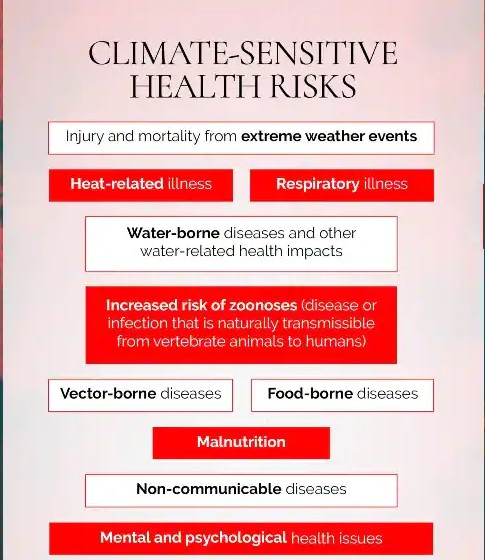
Source:
Devasahayam Pillai
- Context: Devasahayam Pillai will become the first layperson from India to attain sainthood.
- Pope Francis will canonize Blessed Lazarus (Devasahayam Pillai).
- Devasahayam Pillai was born on 23 April, 1712 into a Hindu family at Nattalam village in Tamil Nadu’s Kanyakumari district and grew up in an upper caste family of temple priests.
- He was known as Nilakanda Pillai before converting to Christianity.
- He became a Catholic in 1745, a few years after coming into contact with a captain from the Dutch East India Company while serving the royal house of Travancore.
- Pillai took the Christian name Lazarus, but later came to be known as Devasahayam (God’s help).
- He preached equality of all people despite caste differences that eventually led to his martyrdom.
- In 1749, he was arrested and shot on 14 January 1752 after being subjected to torture.

Source:
The geo-economics of climate finance: ORF
Essence: The editorial emphasizes the need of a humungous US $2.4 trillion by 2035 in energy sector to be able to limit temperature rise to below 1.5 degree Celsius. But the amount that has been promised and the specific finances delivered between the countries internationally are a mismatch. Eg. India had to raise 85% of climate finance through domestic sources in 2018.
Some initiatives that could help in this direction are- firstly, multilateral development banks could act as risk guarantors and bridge the climate investors with recipient countries. Secondly, international finance norms which maintain stringent levels of risk assessment do not suit well for the long-term climate projects. In addition, there needs to be standardization in finance disclosure, rating methodology/taxonomy, addressing information asymmetry, etc. This issue has also been highlighted by RBI. For the same, a task force of FSB on climate related finance disclosures (TCFD) was formed.
Third, role of institutional investors to ensure greening of the financial investments and reducing direct funding of GHG releasing industry sectors becomes important. Lastly, there is a need of consensus on cross-border cooperation across financing, technology transfer, and capacity building to achieve limiting climate change goals.
Why you should read this article?
- To understand the multiple issues in inter-country climate financing.
- To gain an insight into the tectonic shifts required for ESG norms for the future.
Source:
Need to cure Discoms’ health first: BL
Essence: The article highlights the government’s initiative to move towards green and clean energy which has proposed an amendment to Energy Conservation Act, 2001. Along with this amendment, the government is taking many steps to ramp up the demand for the renewable energy. Though the steps have been taken, the success of it to a large extent depend upon the Discoms (distribution companies) which is weakest link in the power sector.
Initiatives have been taken to revive them too like UDAY scheme to bail out DISCOMS and injection of 900 trillion rupees. Despite that it didn’t make much of difference on the dues the Discoms owe to the power generators. If the government wishes to move towards the target it pledges at COP 26, they have to do add on to the existing capacity and provide last mile connectivity. And to provide last mile connectivity sale of Discom is the solution along with ensuring that trading of power should not turn speculative.
Why you should read this article?
- To understand the problems associated with Discom sector.
- To understand the steps India should take to move towards clean energy.
Source:
Creating safe digital spaces: TH
Essence: Online violence and cyberbullying among children have been highlighted by the UNESCO by declaring the first Thursday of November as the International Day against Violence and Bullying at School. Vast number of Indian children have access to internet through their devices and are prone to such violence. Closing of schools due to COVID have increased the cases of cyberbullying and child sexual exploitation. Cyberbullying has negative effects on education, health and well-being of children and young people. There is a need for schools, teachers, parents and Government to come together to provide children with the right knowledge and skills to identify online violence and prevent cyberbullying.
Why should you read this article?
- To understand that online violence and cyberbullying are rising problems among children.
- To know how the online violence among children can be tackled.
Source:
Traditional agriculture against Global warming
Background
- Due to its geographical location, Bangladesh is one of the worst-hit countries in terms of effects of global warming.
- It faces frequent floods which hinders agriculture and the annual cycle of harvesting crops.
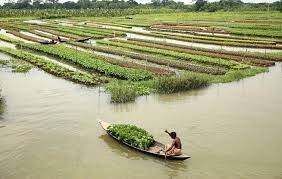
Revival of old traditional methods to rescue:
- Bangladesh farmers revived their century-old technique of soil-free cultivation. Used innovation to the technique and revived it into a technique known as 'Dhap' or 'Baira'
- They are floating beds created with bamboo, water hyacinth, coir and wood chippings.
- These raft-like farms are two to four feet long and can withstand flooding or turbulent waterways.
- Composting is done with used rafts which solves the problem of dumping.
- In December 2015, the UN's Food and Agriculture Organization designated Bangladesh's floating farms method as a globally significant agricultural heritage system.
Quote: Since nature has the most sustainable ecosystem and since ultimately agriculture comes out of nature, our standard for a sustainable world should be nature's own ecosystem. — Wes Jackson
Paper 3: Environment conservation
Source:
Image Source:
Share the article
Get Latest Updates on Offers, Event dates, and free Mentorship sessions.

Get in touch with our Expert Academic Counsellors 👋
FAQs
UPSC Daily Current Affairs focuses on learning current events on a daily basis. An aspirant needs to study regular and updated information about current events, news, and relevant topics that are important for UPSC aspirants. It covers national and international affairs, government policies, socio-economic issues, science and technology advancements, and more.
UPSC Daily Current Affairs provides aspirants with a concise and comprehensive overview of the latest happenings and developments across various fields. It helps aspirants stay updated with current affairs and provides them with valuable insights and analysis, which are essential for answering questions in the UPSC examinations. It enhances their knowledge, analytical skills, and ability to connect current affairs with the UPSC syllabus.
UPSC Daily Current Affairs covers a wide range of topics, including politics, economics, science and technology, environment, social issues, governance, international relations, and more. It offers news summaries, in-depth analyses, editorials, opinion pieces, and relevant study materials. It also provides practice questions and quizzes to help aspirants test their understanding of current affairs.
Edukemy's UPSC Daily Current Affairs can be accessed through:
- UPSC Daily Current Affairs can be accessed through Current Affairs tab at the top of the Main Page of Edukemy.
- Edukemy Mobile app: The Daily Current Affairs can also be access through Edukemy Mobile App.
- Social media: Follow Edukemy’s official social media accounts or pages that provide UPSC Daily Current Affairs updates, including Facebook, Twitter, or Telegram channels.


